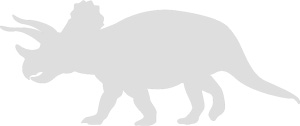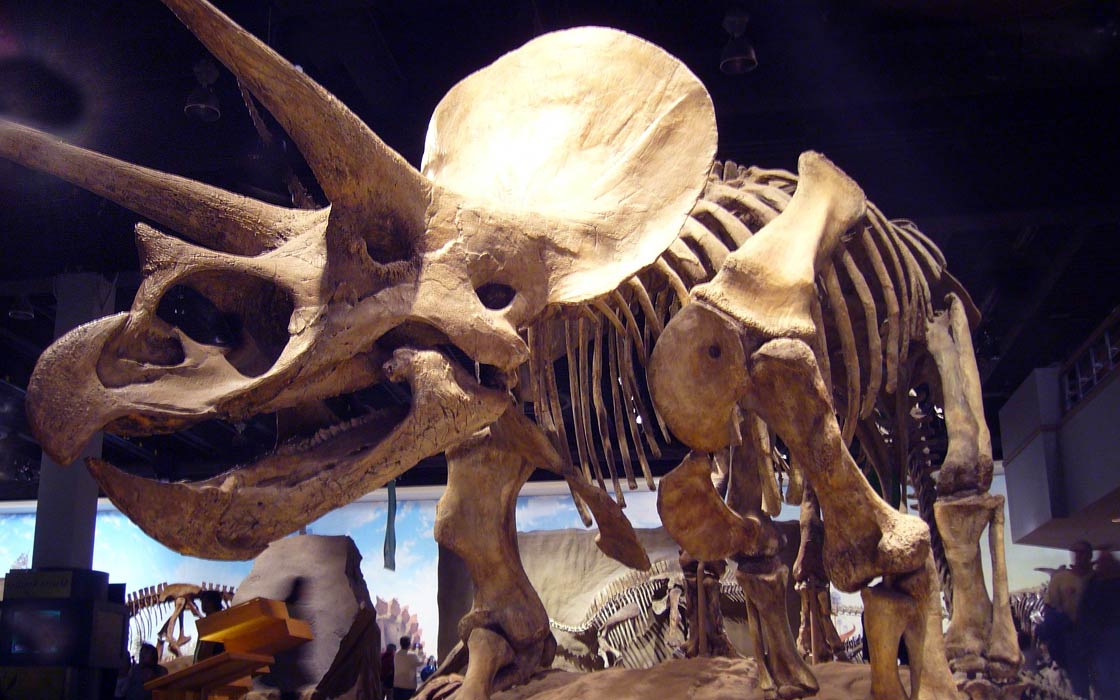Every month, 100,000 readers use the Dinosaur Database, but we receive no support from you. Developing and updating the database requires a lot of work. If you want it to remain open and be updated, please support us via the "Buy us a coffee" button available on every page or via the Support page.
Dinosaur: Triceratops horridus

| Length*: | 8.5 m | 27.9 ft |
| Weight*: | 8.3 t | 18,298 lb |
*The largest known specimen
Period
Epoch: Late Cretaceous
Stage: Late Maastrichtian
Years: 72.1–66 Ma
Details
Status: valid
Author: Marsh
Year: 1889
Distribution
Area: North America
Country: USA, Canada
Region: Wyoming, Montana, South Dakota, North Dakota, Colorado, Saskatchewan, Alberta
Formation: Lance, Laramie, Hell Creek, Denver, Frenchman, Scollard, Evanston
Description
Triceratops horridus
Triceratops horridus is one of the most recognizable and iconic dinosaurs, known for its three distinct facial horns and large bony frill. It lived during the Late Cretaceous period, approximately 68–66 million years ago, in what is now North America. The name “Triceratops” means “three-horned face,” derived from the Greek words “tri” (three), “keras” (horn), and “ops” (face). As a member of the Ceratopsidae family, Triceratops horridus represents one of the last and largest ceratopsians, flourishing right up until the mass extinction event at the end of the Cretaceous.
Physical Characteristics
Triceratops horridus was a large, quadrupedal herbivore, with an estimated length of 8–9 meters (26–30 feet) and a weight of around 6–9 metric tons. It had a massive skull, measuring up to 2.5 meters (8 feet) long, which accounted for nearly one-third of its body length. The skull featured two large brow horns above the eyes and a smaller nasal horn on the snout. The bony frill at the back of its head was solid and likely served multiple functions, including protection, species recognition, and display. Unlike some other ceratopsians with fenestrated (windowed) frills, Triceratops had a solid frill without openings, adding to its robustness. The body was stocky, with strong, muscular limbs that ended in broad, hoof-like claws. The front limbs were slightly shorter than the rear limbs, giving it a slight forward tilt. Its beak-like mouth, fitted with a battery of shearing teeth in the cheeks, was well-adapted for slicing through tough, fibrous vegetation.
Diet and Feeding Habits
As a herbivore, Triceratops horridus fed on a variety of plant material, including cycads, ferns, palms, and flowering plants that were abundant during the Late Cretaceous. Its strong, parrot-like beak was ideal for cropping vegetation, while its teeth, arranged in rows or “dental batteries,” could efficiently shear through tough plant material. These teeth were constantly replaced throughout its life, ensuring a continuous supply for chewing. Given its head structure, Triceratops likely fed on low-lying plants but could also rear up slightly or angle its head to reach higher vegetation. The jaws of Triceratops suggest it was a selective feeder, capable of processing a wide range of plant types. Some studies suggest that Triceratops might have had a specialized diet, possibly favoring certain plant types available in its environment.
Habitat and Distribution
Triceratops horridus lived in what is now North America, primarily in the regions corresponding to modern-day Montana, Wyoming, South Dakota, and Colorado. Fossils have been found predominantly in the Hell Creek Formation, which is known for its rich Late Cretaceous deposits. This environment consisted of floodplains, river deltas, and coastal plains, with a variety of habitats ranging from open forests to fern prairies. The climate was warm and humid, supporting a diverse array of plant life that provided ample food resources for herbivorous dinosaurs like Triceratops. The presence of Triceratops alongside other herbivores like Edmontosaurus and Ankylosaurus suggests a complex ecosystem with diverse feeding strategies and niches.
Behavior and Social Structure
The social behavior of Triceratops horridus remains a subject of debate among paleontologists. Unlike some other ceratopsians, Triceratops fossils are typically found as isolated individuals rather than in groups, which could suggest a more solitary or small-group lifestyle. However, the horns and frill of Triceratops likely played a significant role in social interactions, including mating displays, territory defense, and possibly species recognition. The horns could have been used for combat with rivals or predators, while the frill may have been brightly colored or patterned to attract mates or signal dominance. Some evidence of healed injuries on Triceratops skulls suggests that individuals may have engaged in horn-to-horn combat, similar to behavior seen in modern-day horned mammals like deer and bison.
Discovery and Research
Triceratops horridus was first described in 1889 by the American paleontologist Othniel Charles Marsh, based on fossils discovered in Wyoming. Since then, numerous specimens have been uncovered, making Triceratops one of the most well-known and thoroughly studied dinosaurs. Its fossils are among the most common dinosaur finds in the Late Cretaceous deposits of North America. Recent research has focused on understanding the growth patterns and ontogeny of Triceratops, with studies indicating that the horns and frill changed shape and size as the animal matured. Juvenile Triceratops had shorter horns and less developed frills, which grew and became more pronounced as they aged. The taxonomy of Triceratops has been subject to revision, with some paleontologists proposing that different species, such as Triceratops horridus and Triceratops prorsus, may represent different growth stages rather than separate species.
Significance and Interesting Facts
Triceratops horridus is significant for its role as one of the last-surviving non-avian dinosaurs before the mass extinction event 66 million years ago. Its well-preserved fossils provide key insights into the anatomy, behavior, and evolution of ceratopsians. Triceratops also serves as an example of convergent evolution, with its horns and frill resembling the defensive adaptations seen in modern horned animals. The study of Triceratops contributes to our understanding of dinosaur biodiversity and paleoecology during the Late Cretaceous, particularly in North America. In popular culture, Triceratops has become a symbol of the Cretaceous period and is frequently featured in books, films, and museum exhibits, reflecting its iconic status as one of the most recognizable dinosaurs.
Locations
Sources
Material: At least several dozen individuals.
References: Ostrom, J. H. & Wellnhofer, P. (1986) "The Munich specimen of Triceratops with a revision of the genus". Scannella, John B.; Fowler, Denver W.; Goodwin, Mark B.; Horner, John R. (2014). "Evolutionary trends in Triceratops from the Hell Creek Formation, Montana".Ryan et al. (2010). New Perspectives on Horned Dinosaurs.Weishampel, D. B., Dodson, P., Osmólska, H., & Hilton, Richard P. (2004). The Dinosauria.




